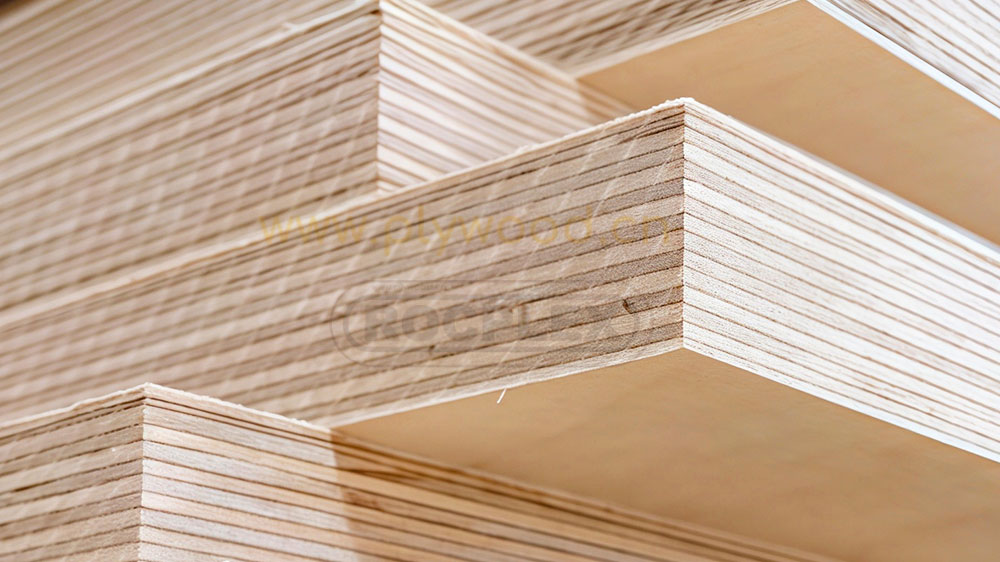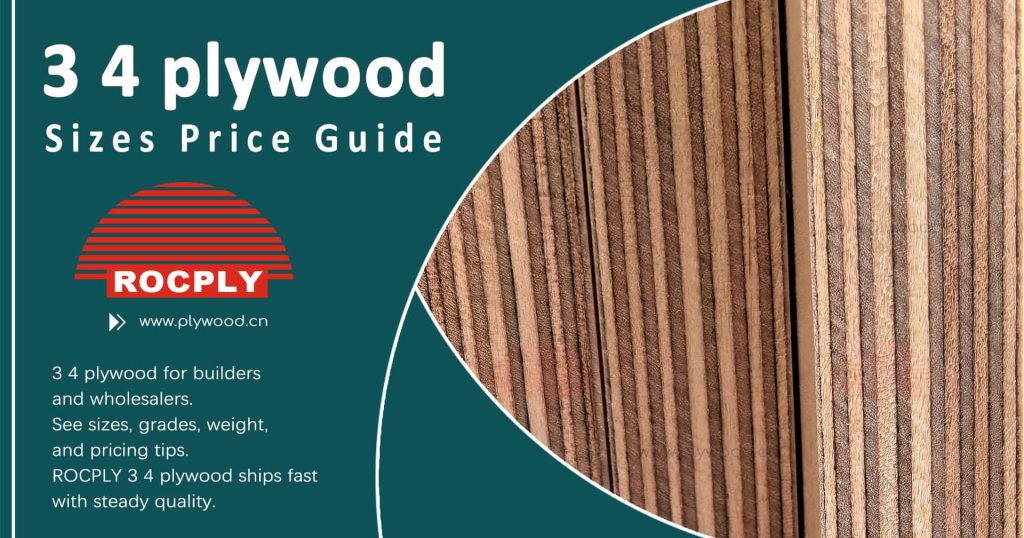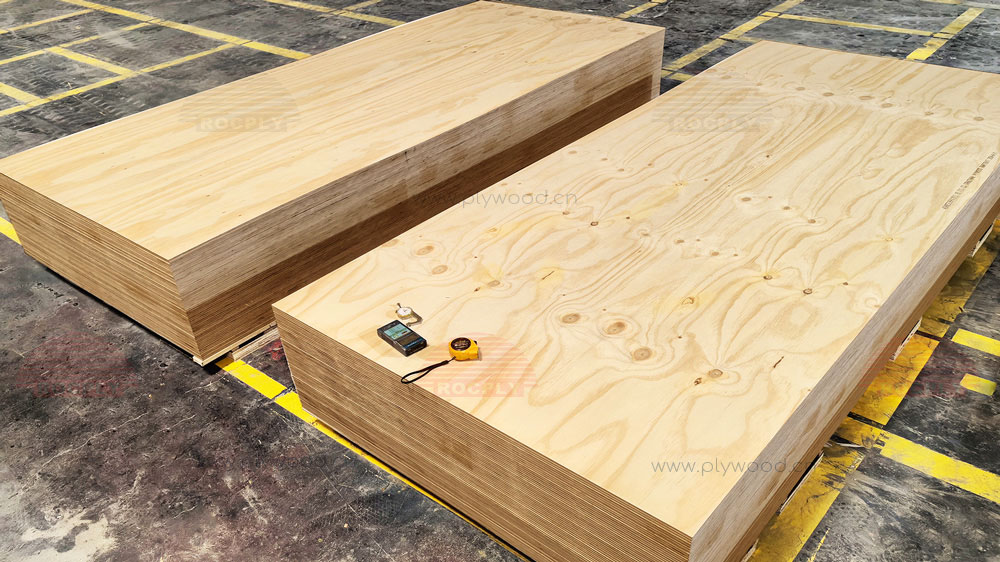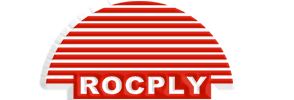3 4 plywood market update and ROCPLY launch
Demand for stiff, reliable sheets keeps rising. Builders need panels that hold fasteners and stay flat. Furniture plants want smooth faces and tight thickness control. ROCPLY answers with an upgraded 3 4 plywood line. The range targets consistent strength, clean sanding, and efficient packing. Buyers gain clarity on specification, labeling, and logistics.
We refined the process from veneer to wrap. Face selection follows strict criteria. Core layup balances weight and stiffness by species. Bonding uses audited glue systems matched to the job. Finally, we pack for long routes and heavy handling. Your team receives flat, traceable pallets that move quickly through the yard.

Why 3 4 plywood wins daily jobs
The 18 mm class brings clear benefits. Panels resist flex on longer spans. Crews get better screw hold and edge durability. Tops, floors, and shop fixtures feel solid under load. The format also supports rapid drilling and pocket joinery. As a result, installers work faster and deliver cleaner lines.
Consistency matters as much as strength. Tight thickness windows reduce sanding and shimming. Straight edges improve layout accuracy. Smooth faces cut the time to primer. These small gains add up across every project.
ROCPLY 3 4 plywood quality promise
Quality starts with the veneer. We grade faces for low patch use and uniform grain. Cores receive a controlled pattern to reduce voids. Glue lines follow robust, documented routines. Each batch records temperature, pressure, and press time. The data supports traceability and quick feedback loops.
Finishing teams value stable faces. Sanding remains predictable across the sheet. Paint holds evenly without surprise blotches. Clear coats reveal a clean, consistent figure. Joiners notice fewer tear-out issues at the edges.
Sizes, tolerances, and plywood sizes clarity
Global trade still centers on 4×8 plywood. ROCPLY ships this format as the primary line. We also supply 1220×2440 mm and 1250×2500 mm. Labels present nominal and metric values for quick checks. Yard teams find the right stack with minimal time.
Tolerance control protects fit. Edge squareness supports tight seams and straight rips. Thickness windows stay narrow to cut rework. You plan labor with more confidence. Waste falls as sheets align to the design.
Key specifications snapshot
| Spec | Detail |
| Standard sizes | 1220×2440 mm, 1250×2500 mm, 4×8 plywood |
| Thickness window | 17.5–19.2 mm (market dependent) |
| Typical tolerance | ±0.4 mm (internal target) |
| Face grades | B/BB, BB/CC, C/D |
| Glue classes | MR (interior), WBP phenolic (exposure) |
| Core options | Poplar, Eucalyptus, Mixed |
| Formaldehyde class | E0 or E1 |
| Typical uses | Floors, benchtops, cabinets, fixtures |
3 4 plywood vs 18mm plywood vs 3/4 plywood
Decision points shift by code and load. 18mm plywood board sits slightly thinner than true three-quarter. Many interior uses still accept it. 3/4 plywood aligns with the nominal class used in North America. Both live near this structural tier, yet local rules can differ. ROCPLY labels each path clearly. Your team selects the approved sheet without doubt.
The thicker track delivers extra stiffness. Floors and benchtops feel solid and quiet. Long shelving spans deflect less under weight. Shops building high-traffic fixtures see fewer failures. The cost difference often returns value through lower rework.

Use cases across trades and channels
Builders rely on this class for subfloors, stair risers, and sturdy linings. Retail fit-outs demand straight edges and durable faces. Furniture plants turn panels into tops, sides, and structural backs. Event teams build stages that survive repeated moves. DIY users trust the format for benches, racks, and tool stations.
Distribution requires breadth as well as depth. Plywood wholesalers carry premium and utility faces. Retailers need clear shelf labels and simple guides. Fabricators want consistent sanding response. ROCPLY supplies the mix and the documentation each channel needs.
Plywood Face grades, species, and core engineering
Face grade sets the finish pathway. B/BB suits paint and visible joinery. BB/CC handles linings and general fit-out. CDX plywood supports crates and temporary structures. The grade map simplifies price tiers and sales choices.
Species drive stiffness, look, and tool wear. Eucalyptus cores increase modulus and screw grip. Birch faces deliver tight grain and refined finish. Pine sands quickly and shows a warm tone. Okoume reduces sheet weight for large runs. Mixed cores balance cost, weight, and hold.
Core engineering limits voids and telegraphing. Cross-band selection improves dimensional stability. Adhesive spread stays consistent across the layup. Press cycles follow a documented envelope. The result is cleaner cuts and stronger edges.
Glue systems, emissions, and interior air quality
Glue choice should match exposure. MR suits dry interiors and furniture parts. WBP phenolic supports wet areas and harsh service. Both run under tight process control. Labels show glue class beside grade and size. You confirm the spec with a quick glance.
Indoor air rules grow stricter each year. ROCPLY offers E0 and E1 options across key lines. Certificates travel with each shipment. The stack label repeats the emissions rating. Buyers can share the data downstream with confidence.
Weight, span guidance, and fasteners
Panel weight depends on species mix and moisture. The 18 mm class still allows safe two-person lifts in most cases. Fork points on the pack guide machine handling. Storage instructions appear on the side label for quick reference.
Span guidance protects safety and finish quality. Designers should consult local tables and approvals. Our team shares data where rules allow. If a job needs a rated panel, we help map the right code path. Good specs prevent costly site changes.
Fasteners decide a lot of outcomes. Dense cores reward pre-drilling near edges. Screw length should match substrate and load. Heads must sit flush, not crushed. Proper spacing keeps lines clean and structural values intact.
Moisture control, finishing steps, and durability
Moisture causes most field issues. Choose the right glue system for the room. Seal edges and faces with the planned coating. Vent concealed spaces to manage trapped humidity. These steps extend service life and protect looks.
Finishing flows better on clean faces. Sand lightly, then vacuum dust. Prime to lock fibers before paint. For clear finishes, pick higher face grades. Edge banding upgrades cabinet life and customer appeal. Small steps add long-term value.

ROCPLY 3 4 plywood packaging and 4×8 efficiency
Good packs save time and money. We wrap with tear-resistant film and edge guards. Straps hold tight during long voyages. Labels face the aisle for quick scanning. Barcodes link to batch and grade. Your team moves freight faster and with fewer errors.
The 4×8 plywood format lifts freight density. Containers load cleanly with square stacks. Yard teams handle packs with minimal reshuffle. Stores present the range with clear blocks and signs. Everything supports a simple pick and sell cycle.
Planning stock for wholesalers and retailers
Assortment drives service levels. Carry premium faces for joinery work. Stock utility boards for site tasks. Keep 18 mm as the heavy-duty anchor. Add plywood sheet options in popular sizes for DIY traffic. Each slot earns its space with clear demand.
We help set reorder points by real turns. Seasonal buffers protect peak months. Mixed containers support small markets without heavy storage costs. Partners gain steadier margins and fewer emergency buys.
Pricing strategy for 3 4 plywood
Strong pricing starts with clear specs. Grade, glue, species, and face all drive value. We quote in simple tiers, so buyers compare like for like. You see packing and documentation costs up front. Sales teams then explain value without guesswork. Volume programs reduce unit cost and stabilize lanes. Longer lanes also protect vessel options and free time. We help model FOB and CIF routes for each port. Landed cost becomes predictable and defensible.
Market shifts still happen. Fuel, surcharges, and exchange rates can move fast. We share triggers and thresholds before they hit. Your team reacts early with transparent offers. Partners trust numbers that match reality on the water.
Total cost beyond sticker price
Sticker price matters. Total plywood cost decides repeat orders. Flat panels cut rework and sanding time. Smooth faces speed primer and finish coats. Tight thickness windows improve fit at assembly. All these gains return cash to your margin.
Returns drain energy and goodwill. We design quality to avoid claims. Bond strength resists delamination through seasons and moves. Labels reduce mis-picks and warehouse errors. Corner protection reduces transit damage. Together, these details protect profit on every load.
Sustainability and compliance
Buyers now demand proof, not slogans. We maintain strong chain-of-custody systems. Audits review veneer sources, glue lines, and packing flows. You receive documents that pass scrutiny. Teams present verified claims with confidence.
Indoor air rules keep tightening. We offer E0 and E1 plywood options across core lines. Labels print the rating on each sheet bundle. Certificates travel with the shipment set. You meet client requests without delay.
Documentation and certifications
Clean paperwork speeds customs. Every shipment includes invoices, packing lists, and certificates. Mill test summaries appear where projects require them. Batch numbers match labels for quick checks. Brokers process files without extra calls.
Due diligence comes built in. We prepare species statements and origin notes on request. Glue class sheets support job submittals. Your compliance team answers questions in minutes, not days. Projects start on time because files arrive complete.
Logistics and packing for 4×8 efficiency
Freight efficiency shapes final cost. Our packs stack square and load fast. Tear-resistant wraps hold through yard moves. Edge guards protect corners during lifts. Straps hold tension for long sea routes. Labels face the aisle, so checks take seconds.
Handling safety matters daily. We mark fork points and clearances on each pack. Crews lift with confidence and avoid damage. Moisture control starts at the mill and continues in transit. Desiccants support long lanes when climates shift.
Logistics and packing overview
| Item | Specification |
| Pallet pack count (18 mm) | Typically 30–40 sheets; custom heights available |
| Wrapping | Tear-resistant film with edge guards |
| Straps | High-tensile PET or steel as required |
| Labels | Barcode, batch, grade, thickness; aisle-facing |
| Moisture control | Target drying plus desiccant on request |
| Forklift handling | Marked lift points and clearances |
Training and after-sales support
Great panels still need great guidance. We train teams on grades, faces, and glue classes. Quick charts map thickness choices to tasks. Short scripts help staff answer common questions. Sales conversations get clearer and faster.
Technical support goes deeper when needed. We share bond data and span references where codes allow. Submittal packs arrive ready for review. When issues surface, we trace the batch and fix causes. The loop protects future loads and your reputation.
FAQ on 3 4 plywood
Is 3 4 plywood the same as 3/4 plywood?
Yes. Both terms point to the same nominal class. Many regions also accept 18mm plywood for similar uses. Always check the tolerance in your spec.
When should I step up from 1/2?
Choose thicker sheets for higher loads and longer spans. Benchtops, floors, and shop fixtures feel better. Fastener grip also improves on dense cores.
What grade should I pick for paint?
Select B/BB or similar smooth faces. Sand lightly and prime to lock fibers. The finish looks clean and stays durable.
Can I use it outdoors?
Yes, with the right system. Choose WBP phenolic glue and seal all edges. Maintain coatings on schedule. Vent cavities to manage humidity.
How do I estimate pallet yield?
Counts vary by region and thickness. Labels show the exact number per pack. We can match pack height to your racking plan.
What about weight per sheet?
Species and moisture affect mass. Your rep can share a current figure by build. Plan lifts and transport with that number.
How does ROCPLY control variation?
We track temperature, pressure, and press time by batch. Veneer grading and adhesive spread follow tight rules. Data supports traceability and steady results.
Ordering and custom options with ROCPLY
Ordering stays simple. Share target uses, grades, and glue class. Confirm sizes, thickness windows, and face expectations. Tell us the port, Incoterms, and document needs. We confirm the lead time and book the lane.
Custom runs solve unique problems. We rip or crosscut to reduce waste in the shop. Surface sanding aligns to your finishing flow. Label sets can mirror your retail system. These options speed warehouse picks and reduce mistakes.
Mixed containers support smaller markets. Combine 3 4 plywood with select utility grades. Add a base of plywood board for steady DIY demand. This mix protects service levels without heavy stock.
Case snapshots from the field
A Southeast Asian distributor split assortments by channel. Premium faces went to cabinet lines. Utility faces served site linings and crating. Returns fell, and margins rose. Forecasting improved with rolling orders and buffers.
An Oceania retailer needed faster checks. We aligned SKUs and barcodes to their ERP. Yard picks sped up by minutes per pack. Mis-shipments dropped sharply. Customer feedback turned positive within one quarter.
A furniture plant sought smoother finishing. We specified a birch face and poplar core. Sanding times dropped, and output rose. The team reported cleaner edges and fewer rejects.
Safety and handling reminders
Train crews on safe lifts and edge care. Keep blades sharp to reduce tear-out. Use gloves and eye protection during cutting. Store packs flat on dry, level supports. Avoid long sun exposure before install. These habits protect finish and schedule.
Why buyers choose ROCPLY 3 4 plywood
Consistency wins busy weeks. ROCPLY 3 4 plywood arrives flat, smooth, and on spec. Cores hold thickness and resist voids. Bond lines meet strict internal targets. Crews notice clean cuts and tight edges. Managers see fewer callbacks and steadier margins.
Packaging supports the last mile. Packs arrive square and scan fast. Warehouse moves take less time. Stores present stock with clear labels. Everything pushes projects forward.
Pricing, value, and plywood price clarity
We publish transparent structures for each grade. Surcharges appear before booking, not after. You compare options with confidence. Negotiations focus on value rather than mystery fees. Over time, trust compounds into long contracts.
Secure your 3 4 plywood supply today
Projects demand stable panels and clear documents. ROCPLY delivers both with care and speed. Your teams work faster and waste less. Clients notice the finish and the fit. Book ROCPLY 3 4 plywood for your next window. We will align specs, mixes, and timelines. Then we will ship clean packs that keep your schedule on track.

Plywood
ROCPLY, a trusted name in the construction materials market, is proud to announce the launch of their new line of high-quality ply wood solutions. Designed to meet the diverse needs of the industry, ROCPLY now offers an extensive range of ply options, including structural, birch, marine, and MR plywood.
ROCPLY Plywood Superior Quality and Durability:
ROCPLY ply solutions are meticulously crafted to deliver superior quality and durability. The structural ply offers exceptional strength and stability, making it ideal for applications that require reliable load-bearing capabilities. Birch ply wood, known for its fine grain and consistent thickness, provides versatility and aesthetic appeal. The marine ply wood is specially treated to withstand moisture and weather conditions, making it perfect for marine and outdoor projects. Lastly, the MR ply wood offers moisture resistance, making it suitable for interior applications where protection against humidity is essential.
ROCPLY Plywood Wide Range of Applications:
ROCPLY ply wood products cater to various industries and applications. The structural ply is widely used in commercial and residential construction projects, including flooring, roofing, and formwork. Birch plywood is sought after by architects and designers for its versatility in furniture making, cabinetry, and interior fittings. Marine plywood is a top choice for boat building, docks, and other water-related structures due to its water-resistant properties. MR plywood finds applications in indoor furniture, cabinets, and decorative purposes, offering both functionality and style.
ROCPLY Plywood Commitment to Quality and Sustainability:
ROCPLY is committed to delivering ply wood solutions that not only meet high-quality standards but also adhere to sustainable practices. Their ply is sourced from responsibly managed forests, ensuring a minimal impact on the environment. With ROCPLY’s plywood options, builders and architects can confidently create sustainable and eco-friendly structures without compromising on performance.
We are thrilled to introduce our new line of ply wood solutions. At ROCPLY, we strive to provide our customers with the finest quality materials that meet their specific requirements. With our range of structural, birch, marine, and MR plywood, we aim to empower builders, architects, and craftsmen to bring their visions to life.
For more information about ROCPLY’s plywood solutions and to request samples, please visit [website] or contact [contact details].
About ROCPLY Plywood:
ROCPLY is a leading brand in the construction materials industry, known for delivering high-quality products to wholesalers, builders, and contractors. With a commitment to innovation, sustainability, and customer satisfaction, ROCPLY offers a wide range of construction timber material.
Post time: Nov-17-2025

